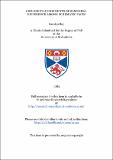Files in this item
Children's judgements of sameness-difference among schematic faces
Item metadata
| dc.contributor.advisor | Wales, Roger | |
| dc.contributor.advisor | Grieve, Robert | |
| dc.contributor.advisor | Quinalt, Frank | |
| dc.contributor.author | Roy, Carolyn Mary | |
| dc.coverage.spatial | 283, xxiii, xviii p. | en_US |
| dc.date.accessioned | 2018-07-09T15:09:19Z | |
| dc.date.available | 2018-07-09T15:09:19Z | |
| dc.date.issued | 1983 | |
| dc.identifier.uri | https://hdl.handle.net/10023/15143 | |
| dc.description.abstract | Researchers have found that young children often make "confusion errors" in judging visual stimuli for sameness. That is, children are reported to treat as "just the same" stimuli that are not identical in all respects. Explanations of these confusion errors have focussed on separate aspects of children's performance: language development (e.g., acquisition of relational terms), or perceptual and cognitive development (e.g., visual scanning or selection of criteria! features). The latter appear more successful in explaining the types of errors manifested. For instance, Taylor (1973) found that children, judging sameness among schematic faces, consistently correctly matched particular features and confused others, and later evidence (Wales, pers. comm., 1974) suggested their responses may be affected by the presence or absence of a visual frame around the face .The present series of experiments investigated potential influences on judgments of sameness among sets of schematic faces by children of pre-school and early school age. Variables examined included presence of a visual frame of reference around the face, type of stimulus array, task requirements, and salience of stimulus features relative to each other. Initial results confirmed that, in tasks like matching-from-sample or pair-comparison, children systematically matched only certain features of the faces and confused other features. Type of task (including stimulus and response variables) and presence/absence of a visual frame interacted with each other to influence the response patterns. Subsequent experiments suggested that neither objective visual salience of one stimulus feature over another, nor selection of a visual criterial attribute, satisfactorily accounted for the observed response patterns. A more likely contributor was subjective weighting of features on grounds of their contextually-afforded significance. Faces were not compared feature-by-feature; instead, the criterion seemed to be sameness of affective expression conveyed. It is argued that many of the confusion errors were not due simply to linguistic or perceptual immaturity. Rather, in circumstances where adults take "same" to refer to identity across all features, the children took it as "same kind of thing": their responses reflected their bases for classifying the faces (i.e., by affective content) rather than ability to judge identity. Having judged unidentical faces as the same, a considerable number of children indicated in justifying their judgments that while certain features were the same, others were not. Thus they appeared able to understand and use "same" in its various adult senses, but interpreted the task instructions differently from adults. | en_US |
| dc.language.iso | en | en_US |
| dc.publisher | University of St Andrews | |
| dc.subject.lcc | BF723.C5R7 | en |
| dc.subject.lcsh | Cognition in children | en |
| dc.title | Children's judgements of sameness-difference among schematic faces | en_US |
| dc.type | Thesis | en_US |
| dc.contributor.sponsor | Medical Research Council (MRC) | en_US |
| dc.type.qualificationlevel | Doctoral | en_US |
| dc.type.qualificationname | PhD Doctor of Philosophy | en_US |
| dc.publisher.institution | The University of St Andrews | en_US |
This item appears in the following Collection(s)
Items in the St Andrews Research Repository are protected by copyright, with all rights reserved, unless otherwise indicated.

